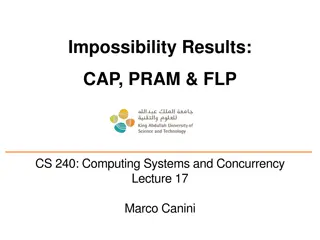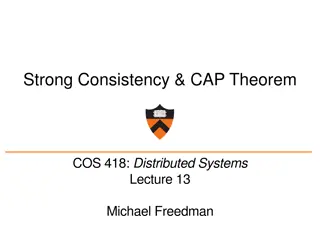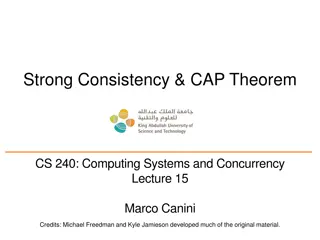Understanding the CAP Theorem in Distributed Systems
The CAP Theorem, as discussed by Seth Gilbert and Nancy A. Lynch, highlights the tradeoffs between Consistency, Availability, and Partition Tolerance in distributed systems. It explains how a distributed service cannot provide all three aspects simultaneously, leading to practical compromises and redefined terms to operate efficiently in unreliable environments. The paper provides proofs and examples to illustrate the challenges and implications of the CAP Theorem in designing distributed systems.
Uploaded on Sep 24, 2024 | 0 Views
Download Presentation

Please find below an Image/Link to download the presentation.
The content on the website is provided AS IS for your information and personal use only. It may not be sold, licensed, or shared on other websites without obtaining consent from the author. Download presentation by click this link. If you encounter any issues during the download, it is possible that the publisher has removed the file from their server.
E N D
Presentation Transcript
PERSPECTIVES ON THE CAP THEOREM Seth Gilbert, National U of Singapore Nancy A. Lynch, MIT
Paper highlights The CAP theorem as a negative result Cannot have Consistency + Availability + Partition Tolerance Tradeoffs between safety and liveness in unreliable systems Asynchronous systems Synchronous systems Asynchronous systems with failure detectors Some practical compromises
Redefining the terms Consistency Distributed system operates as if it was fully centralized One single view of the state of the system Availability System remains able to process requests in the presence of partial failures Partition tolerance System remains able to process requests in the presence of communication failures
The CAP theorem A distributed service cannot provide Consistency Availability Partition tolerance at the same time
Proof (I) Assume the service consists of servers p1, p2, ..., pn, along with an arbitrary set of clients. Consider an execution in which the servers are partitioned into two disjoint sets: {p1} and {p2, ..., pn}. p1 pn p2
Proof (II) Some client sends a read request to server p2 Consider the following two cases: 1. A previous write of value v1 has been requested of p1, and p1 has sent an okresponse. 2. A previous write of value v2 has been requested of p1, and p1 has sent an okresponse No matter how long p2 waits, it cannot distinguish these two cases It cannot determine whether to return response v1 or v2.
The triangle Partition tolerance yes yes Consistency Availability yes
An example Taking reservations for a concert Distributed system Clients send to local server a reservation request Server returns the reserved seat(s).
A system that is consistent and available Use write all available/read any policy All operational servers are always up to date When a site crashes, it does no process requests until it has uploaded the state of the system from one of the running servers Works very well as long as there are no network partitions p1 p2 p3
A system that is consistent and tolerates partitions Require all read and writes to involve a majority of the servers Majority consensus voting (MCV) System with 2k + 1 servers can tolerate the failure or the isolation of up to k of its servers p1 p2 p3
A system that is highly available and tolerates partitions Distribute the seats among the servers according to expected demand Tolerates partitions No coherent global state p2 p3 p1
Comments The theorem states that we have to choose between consistency and availability But only in the presence of network partitions. Otherwise we can have both.
Generalization A safety property Must always hold Such as consistency A liveness property Means that the system will make progress CAP theorem states we cannot guarantee both safety and liveness in the presence of network partitions .
Asynchronous systems (I) Two main characteristics Non-blocking sends and receive Unbounded message transmission times Define consensus as Agreement among all processes on a single output value Validity: That value must have proposed by some process Termination: That value will eventually be output by all processes
Asynchronous systems (II) Fischer, Lynch and Paterson (1985) No consensus protocol is totally correct in spite of one fault. There will always becircumstances under which the protocol remains forever indecisive.
Synchronous systems (I) Three conditions Every process has a clock and all clocks are synchronized Every message is delivered within a fixed and known amount of time Every process takes steps at a fixed and known rate Can assume that all communications proceed in rounds In each round a process may send all the messages it requires while receiving all messages that were sent to it in that round
Synchronous systems (II) Lamport and Fischer (1984); Lynch (1996) Consensus requires f + 1 rounds, if up to fservers can crash. Dwork, Lynch and Stockmeyer (1988) Eventual synchrony System can experience periods of asynchrony but will eventually maintain synchrony long enough to achieve consensus Consensus requires f + 2 rounds of synchrony
Synchronous systems (III) Assuming no tie- breaking rule. Still limited by partitioning risk System with nnodes can tolerate < n/2 crash failures With a tie-breaking rule, a system with 2n nodes can tolerate n - 1 crash failures and 50 percent of n crash failures
Failure detectors Chandra et al. (1996) Detect node failure and crashes Hello protocol, exchanging heartbeats Allow consensus in asynchronous failure-prone systems Raft
Set agreement Can have up to kdistinct correct outputs k-setagreement Not covered
Best effort availability Put consistency ahead of availability Chubby Distributed database with primary + backup design Based on Lamport s Paxos protocol Provides strong consistency among the servers using a replicated state machine protocol Can operate as long as half the servers remain available and the network is reliable
Best effort consistency Sacrifice consistency to maintain availability Akamai System of distributed web caches Store images and videos contained in web pages Cache updates are not instantaneous Service does its best to provide up-to-date contents Does not guarantee all users will always get the same version of the cached data
Balancing consistency and availability Put limits on how out-of-date some data may be Can make the constraint tunable TACT Yu and Vadat (2006) Airline reservation system Can rely on slightly out-of-date data as long as there are enough empty seats Not so true otherwise
Segmenting consistency and availability (I) Data partitioning Some data must be kept more consistent than others In an online shopping service User can tolerate slightly inconsistent inventory data Not true for checkout, billing and shipping records!
Segmenting consistency and availability (II) Operational partitioning Maintain read access while preventing updates during a network partition Write all/read any policy
Segmenting consistency and availability (III) Functional partitioning Have different requirements for different subservices Chubby Strong consistency for coarse-grained locks Weaker consistency for DNS requests
Segmenting consistency and availability (IV) User partitioning Not covered Hierarchical partitioning Not covered






















